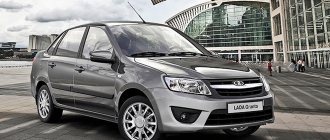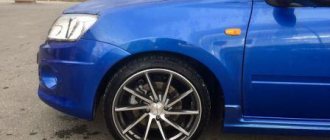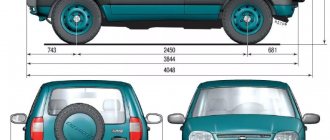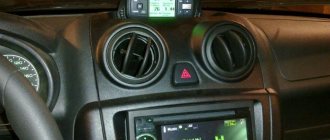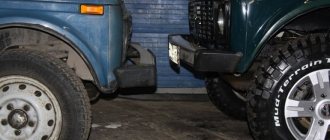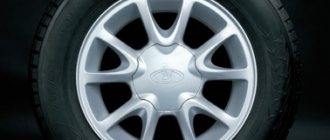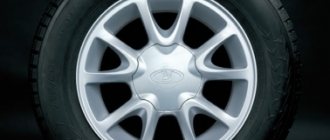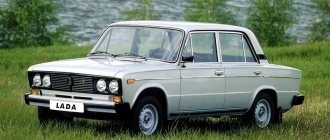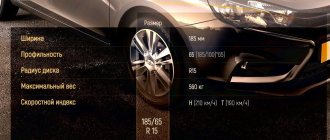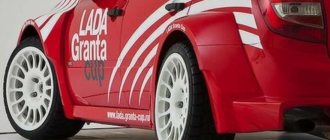Tire size is one of the most important parameters that can significantly change the behavior of a car on the road. In our review we will tell you about the permissible tire size on the Grant, as well as what the size of the tires affects during the operation of the car. Let's start with the tire and wheel sizes allowed by the manufacturer.
Standard Lada Granta wheel sizes
Depending on the vehicle's configuration, it may use tires and wheels of different diameters and widths. The year of manufacture of the car also plays an important role.
The first generation of Lada Granta was equipped with wheels with the following parameters:
| Equipment | Tire size | Disc offset |
| Standard | 175/70R13 or 175/65R14 | 35 |
| Norm | 185/60R14 | 35 |
| Lux | 185/55R15 | 35 |
| Sport | 195/50R16 | 35 |
Many people mistakenly perceive the letter R as a “radius”, but in fact, it only means the structure of the tire – radial. The numbers after the letter R are the diameter of the disc in inches.
Since 2022, the configurations have changed slightly. Now tires and wheels are installed in the following sizes:
| Equipment | Tire sizes | Disc offset |
| Standard | 175/65R14 | 35 |
| Norm | 185/60R14 | 35 |
| Lux | 185/55R15 | 35 |
| Cross | 195/55R15 | 33 |
These are all the standard sizes of tires and wheels that are installed on the Lada Granta from the factory.
What are the maximum wheels you can put on a Grant?
It is worth noting that the permissible tire and wheel sizes must not be exceeded. It is not by chance that the manufacturer sets these restrictions.
First of all, a large wheel will touch the arch or fender liner and prevent the wheel from fully turning when cornering.
The second point is the huge load on the wheel bearings. The larger the diameter of the wheel and the more it weighs, the more the bearing is loaded. Eventually, it begins to hum due to wear and tear and fails.
The maximum wheel and tire size allowed by the manufacturer is as follows:
- 185/65 R15;
- 195/60 R15;
- 195/55 R16;
- 185/40R17.
Many car owners managed to replace the standard tires with size 205/70R16. This can only be done on a Lada Granta Cross and then with a lifted suspension. But this is nothing good for the car.
When replacing disks, it is important to install the appropriate bolts and observe the wheel bolt pattern of the Lada Granta - 4x98.
This list can be continued indefinitely. The fact is that the profile also affects the possible diameter. The smaller the tire profile, the larger the rim that can be installed on the car.
It is worth noting that Granta has the potential to install larger wheels. For this purpose, a special limiter was even provided on the standard steering rack, which prevents the wheels from touching the fender liners with a large turnout.
The best summer tire manufacturers
The highest quality car tires are produced by European, Japanese and Korean manufacturers. To reduce production costs and reduce logistics costs, many manufacturers have opened production facilities in the Russian Federation.
Wear-resistant rubber is used to produce summer tires, ensuring trajectory stability when driving on both dry and wet roads.
The average cost of standard 185/65R14 tires manufactured by companies from the top 9 is shown in the table.
| Manufacturer | Price, thousand rubles |
| Nokian Hakka Green 2 | 3,1 |
| Nokian Nordman SX2 | 2,7 |
| Michelin Energy XM2+ | 3,9 |
| Michelin Energy XM2 | 3,8 |
| Kumho Ecowing ES31 | 2,4 |
| Bridgestone Ecopia EP150 | 2,9 |
| Yokohama BluEarth ES32 | 2,7 |
| Toyo NanoEnergy 3 | 2,5 |
| Toyo Proxes CF2 | 2,5 |
| Toyo Tranpath mpZ | 2,8 |
| Continental EcoContact 6 | 4,1 |
| Hankook Kinergy Eco 2 K435 | 2,9 |
| Hankook Optimo ME02 K424 | 2,9 |
| Matador MP 47 Hectorra 3 | 2,4 |
Finnish company Nokian
For installation on Lada Priora and similar cars, tires of the Hakka Green 2 and Nordman SX2 series, which are produced at the Russian Nokian plant, are offered.
Nordman SX2 tires have a road tread pattern with grooves that reduce the risk of aquaplaning, and the rubber compound is highly wear-resistant.
The improved Hakka Green 2 model ensures reduced fuel consumption, increases vehicle stability when driving on wet roads, and the service life (compared to the previous series) is increased by 15%.
Famous Michelin tires
If the car owner plans to take good tires for the summer, then you can choose Energy XM2+ or XM2 products from the French concern Michelin.
To make tires, a special rubber mixture with strong intermolecular bonds is used, which increases wear resistance.
The sidewall is made using Ironflex technology, which reduces the risk of cord failure when hitting the edges of holes or running into curbs.
Fluid drainage channels located on the treadmill increase the speed at which hydroplaning begins.
Korean Kumho tires
Inexpensive South Korean Kumho tires are supplied to the assembly lines of automobile factories and the spare parts market.
If a driver is looking for lightweight tires, then they should pay attention to the Ecowing ES31 model (introduced in 2022) with a diameter of R14, which comes in several sizes, including the standards 175/70 and 175/65 suitable for VAZ cars.
The product reduces fuel consumption, and the soft sidewall helps reduce noise when driving on asphalt roads.
Bridgestone Company
The Ecopia EP150 tires offered by the Japanese company Bridgestone provide a reduction in fuel costs (according to the manufacturer's measurements, savings reach 7.1%).
The rubber mass has increased hardness, which reduces the rate of wear, but car owners note poor braking performance on wet and dry surfaces.
Touring FS100 tires manufactured by the American branch of Firestone, which have similar performance characteristics, are occasionally found on the territory of the Russian Federation.
Budget tires from Yokohama
If a car owner is deciding which tires to buy for summer use, then you can purchase Japanese Yokohama BluEarth ES32 tires, which provide reliable contact with dry or wet roads.
The original tread pattern allows you to evenly distribute the load in the contact patch and reduce the wear rate.
The rubber mixture was developed using nanotechnology, which made it possible to reduce rolling resistance and fuel consumption.
Japanese manufacturer Toyo
The Toyo plant's production program includes several models of R14 tires:
- Toyo NanoEnergy 3, created using Toyo Nano Balance technology. The tires have increased resistance to aquaplaning, reduce fuel consumption, and increase comfort when driving on paved roads and dirt roads.
- Toyo Proxes CF2, made from a mixture of silicone and polymer additives. They are characterized by increased wear resistance and provide acoustic comfort in the car interior.
- Toyo Tranpath mpZ with an original asymmetrical tread pattern developed using T-Mode technology.
Continental tires
The company offers tires of the EcoContact 3, 5 and 6 models, which differ in the composition of the rubber compound (the latest generation uses Green Chili 2.0 material with increased abrasion resistance). The tires reduce fuel consumption and noise levels due to a special tread pattern.
The advantage is a reduction in braking distance on both dry and wet road surfaces.
Hankook is a Korean company
The South Korean manufacturer offers 2 models of tires with size R14:
- Hankook Kinergy Eco 2 K435, which has widened side grooves on the treadmill to improve hydroplaning resistance. In addition to the polyester tape carcass, an expanded metal belt is used, which improves the tire's performance on dry or wet surfaces.
- Hankook Optimo ME02 K424, made from a mixture with increased wear resistance and thermal strength. The advantage of the tires is the reduced noise level (due to the use of rib-type blocks on the shoulder area of the tread). To increase the strength of the sidewall, a filler with increased hardness was used, which further improves directional stability.
Matador Company
The Matador manufacturer, part of the Continental concern, offers budget MP 47 Hectorra 3 tires that provide increased driving safety on wet road surfaces.
By increasing the hardness of the rubber mass, an increase in mileage has been achieved while reducing noise.
Symmetrical grooves on the tread ensure fluid drainage from the contact patch, and additional blocks in the central section increase traction force transmission.
What tire pressure should be on Grant
In addition to the wheel size, it is also necessary to observe such a parameter as tire pressure. Do not forget that the pressure can be different and it accordingly affects the handling of the car and tire wear:
- Low pressure is dangerous when cornering. You can “take off” the wheel while driving. In addition, tire wear increases along the edges of the tread.
- High pressure - reduces the grip of the wheels on the road, increases the likelihood of a tire explosion, and tread wear increases in the middle.
Tire pressure should always be rated and depends on the vehicle load. Normal pressure is as follows:
- For R13 – 1.9 atm.
- For R14 and R15 – 2.0 atm.
When loading the car, you should increase the tire pressure to 2.1, 2.2, 2.3 in accordance with the weight of the load. This will help maintain tire traction and maintain efficiency.
Paying for savings
Premium segment tires are sold significantly more expensive than others. Is the buyer overpaying for a big name? In part, yes. But there is another factor: the difference in price is, in fact, an additional payment for confidence in the high level of all characteristics.
The middle price group is filled either with products from companies without leadership ambitions, or second brands of famous manufacturers. There you have the greatest chance of finding offers with an adequate balance of quality and price. Often, representatives of this group go from solid to excellent students, and weaklings are extremely rare.
In the economy segment, there is a high risk of running into a product with a low level of consumer properties. The test results show that at the same minimum price, the Wheel of Fortune can take you to both great deals ( GT Radial
), as well as dubious or even dangerous (the trinity
Achilles
,
Sailun
and
Landsail
).
In order not to cross the line beyond which savings can go sideways, be especially wary of unfamiliar brands that do not have a long enough history or a successful and experienced “big brother”. Don’t forget what Pushkin’s Balda said, giving his butt a slap on the forehead after doing free work: “Don’t you, priest, chase after cheapness!”
Together with the authors, Anton ANANEV, Vladimir KOLESOV, Yuri KUROCHKIN, Anton MISHIN, Andrey OBRAZUMOV and Valery PAVLOV took part in the tire testing.
We express our gratitude to the tire manufacturing companies that provided their products for testing, as well as to the employees of the AVTOVAZ test site and the Tolyatti company Shintorg for technical support.
Great test of 14-inch tires. And the “Chinese” are not so bad!
Is it worth increasing the Lada Granta track?
The track is the width between wheels located on the same axle. Increasing the track width allows the installation of wider wheels and improves vehicle handling, especially with a large suspension lift. But it’s clearly not worth increasing the track on Grant.
The track can be increased by using special spacers for the hub. Each car owner decides for himself whether to increase the track or not. But it’s worth knowing how this will affect other components of the car.
The fact is that the thicker the hub becomes and the thicker the wheel, the more the wheel bearing wears out. In addition, such tuning can negatively affect the drives. The grenades will be seriously loaded.
It is possible to carry out such tuning, but provided that a reinforced wheel hub is used, an appropriate bearing, and also paired with good drives.
How non-standard wheels can affect
Wheel parameters can affect vehicle handling and comfort. But it should be taken into account that the better the car’s handling, the worse this affects the comfort of the suspension.
The smaller the rubber profile and the larger the disc diameter, the better the Granta’s handling. In addition, fuel consumption increases, steering accuracy increases, but the noise of the tires and the vehicle's resistance to aquaplaning do not change. Of course, a large disc will negatively affect comfort.
Tire and wheel width can also affect handling, stability and increased tire wear. The width of the tires will also negatively affect the vehicle's resistance to hydroplaning, but can increase traction, provided the road surface is dry. Ideally, asphalt.
The width of the tires plays virtually no role in improving or deteriorating comfort.
A smaller rim means the use of rubber with a larger profile. Consequently, the wheels will be softer, which means increased comfort. But you need to understand that such a configuration does not fit in with improved handling.
Do not forget that the size of the disk can also affect the dynamic performance of the car. The manufacturer uses tire and wheel sizes at which speed and acceleration will be the highest, and the load on the engine and transmission will be minimal.
Deviation from these dimensions entails certain consequences - reduced dynamics, inaccurate speedometer readings and much more.
The width of the rims and their diameter can affect the suspension geometry. Therefore, after installing large wheels, it is necessary to do a wheel alignment.
Selection of tires by model
Knowing the size of the “shoes”, all that remains is to choose the style. Any car should have two sets of tires: winter and summer. Winter tires are installed without waiting for frost, but when the thermometer regularly drops below +5 degrees.
To save on the purchase of winter tires, some drivers make the mistaken decision to drive all-season tires. Therefore, we will make a small digression and explain why this should not be done.
When and what tires are needed for a car?
Let’s say right away that there are no tires that behave stably in any conditions. Why then is the tire called all-season? Because of the tread, which must have a deep relief and grooves through which water, dirt, and slush can easily pass.
All-season tires are tires that are comfortable to drive in the off-season, when the air temperature varies from +7 to -10 degrees. It is often marked M+S (mud/snow), which confuses many.
But in fact, an all-season tire is a summer tire and is not suitable for year-round driving, even in the southern regions of the country.
- All mud tires, and all winter tires, have an all-season tread. The only difference is in the rubber composition, which is designed for positive or negative wheel operation. On a winter tire, for better grip on icy roads, many thread-like sipes are made, which distinguishes it from all-season tires.
- Studless winter tires are popularly called Velcro. On such tires, the car feels great in icy conditions, but when the temperature outside is consistently positive (above +6-7 degrees), it must be changed to summer shoes.
- Winter tires are much softer, so if you try to drive them in the summer, they will wear out quickly. Studded tires are better suited for driving on snow, so when in winter you have to drive not on cleared asphalt, but on a country road, it is better to give preference to studded tires.
- All year round, all-season vehicles are driven mainly by trucks and buses, on which changing wheels is a labor-intensive process, and besides, there are usually more than four of them. True, in severe frosts and snowfalls they have a hard time riding on such tires.
And another important factor is for those who spend a lot of time driving. A tire for winter use is much softer than a summer one, but it is also noisy when driving, especially the studded one.
The summer one, and it is also an all-season one, in severe frosts “steals” and just rattles. And this is not to mention the fact that you will not so much ride on the ice as perform figure skating.
